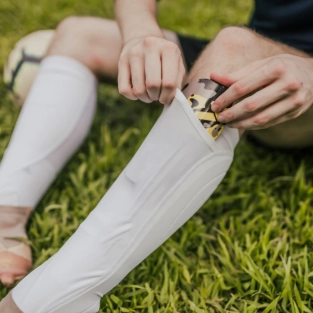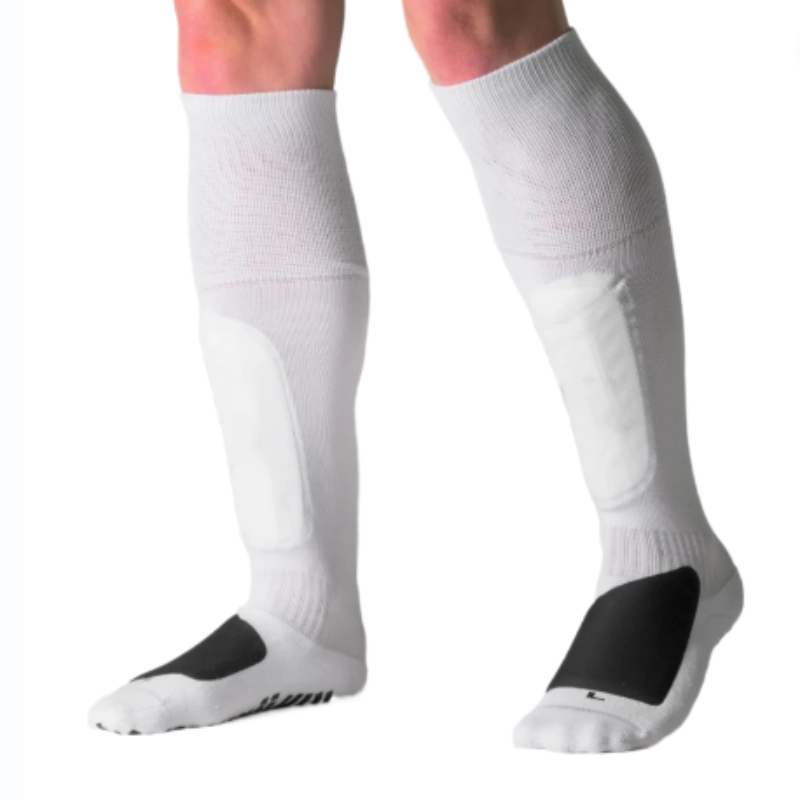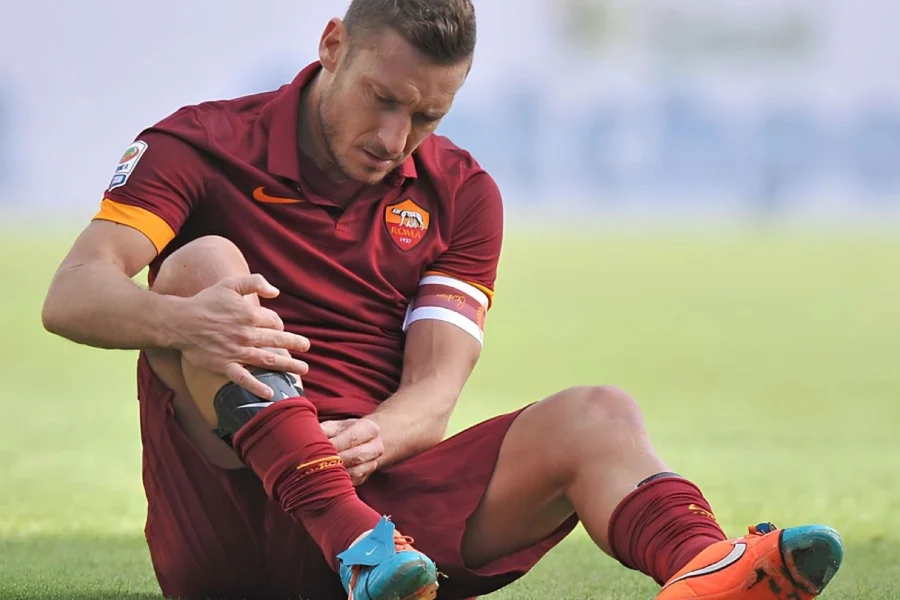Introduction: The Frustration of Slipping Shin Guards
Soccer players at all levels share a common frustration – shin guards that constantly slip during intense gameplay. This not only creates discomfort but also poses serious safety risks when protection isn’t where it should be during crucial moments. The integration of specialized soccer shin guard socks has revolutionized how players secure their protective equipment, offering both functionality and comfort. This comprehensive guide explores the various methods and products designed to keep your shin guards firmly in place, allowing you to focus entirely on your performance on the field rather than adjusting your gear.

The Evolution of Soccer Protective Gear
From Primitive Protection to Modern Solutions
The history of shin protection in soccer dates back to the sport’s earliest days, when players would stuff newspapers, cardboard, or magazines down their socks. This primitive method provided minimal protection and offered no stability during play. As the game grew faster and more physical, so did the need for better gear. Over the decades, materials like leather, foam, and later high-impact plastics became standard. Today’s shin guard systems incorporate lightweight polymers, breathable padding, and anatomical shaping. This evolution reflects not just technological advancement but also a better understanding of athlete comfort and injury prevention.
Modern solutions now include integrated shin guard socks—specially designed to hold guards in place without tape or constant readjustment. These designs reflect years of feedback from players, coaches, and sports medicine professionals. They address not only protection but also practical gameplay challenges such as fit, movement, and sweat management.
Understanding the Anatomy of Modern Shin Guards
Modern shin guards come in two main styles: slip-in and ankle-guard types. The slip-in design is sleek, offering minimal interference with movement, while the ankle-guard models include additional padding to protect vulnerable areas around the foot. Both feature a hard polypropylene shell and soft inner cushioning, often made from EVA foam. Some also include ventilation channels to enhance airflow. Choosing the right design depends on player position, preference, and age group. Equally important is how the guard interfaces with socks or sleeves to stay in place.
Integration with Socks and Compression Wear
The latest generation of shin guards often works hand-in-hand with compression sleeves or specially designed grip socks. These accessories help prevent shifting by providing a tight yet comfortable hold around the calf. Compression also aids in blood flow, reducing fatigue during matches. Many players now use sleeves or socks with built-in shin guard pockets, eliminating the need for tape and streamlining pre-game prep. This integration represents a complete system—gear that functions together for optimal performance and safety.
Specialized Soccer Socks with Built-in Sleeves
How Compression Technology Enhances Guard Stability
Compression technology has transformed how athletes approach equipment stability. Soccer socks incorporating strategic compression zones create a secure environment for shin guards, utilizing pressure mapping to target areas most prone to slippage. The elasticity of these specialized fabrics works dynamically with player movement, maintaining consistent pressure even during the most aggressive plays. This technology not only keeps guards in place but also provides muscular support that can enhance performance and reduce fatigue.
Compression socks can also reduce the amount of tape or accessories needed, streamlining pre-match routines. For younger players or those in fast-paced settings, this simplicity improves efficiency and ensures the gear stays in place without frequent mid-game adjustments.
Top-Rated Shin Guard Socks Worth Investing In
The market offers numerous options for specialized shin guard socks, with standout products from brands like Max Hosiery leading the innovation. These purpose-built socks feature dedicated pouches or sleeves that cradle the shin guard, eliminating the space where movement and slippage typically occur. Premium options incorporate moisture-wicking fabrics that prevent the slickness that often contributes to guard displacement, while antimicrobial treatments ensure freshness during extended use. When selecting these specialized socks, look for reinforced stitching at stress points and graduated compression that promotes both stability and circulation.
Maintenance and Long-Term Wear
To ensure performance over time, players should follow proper care guidelines—wash in cold water, avoid fabric softeners, and air dry. Consistent washing habits help maintain elasticity, while avoiding high heat prevents breakdown of compression fibers. For players training multiple times per week, having a rotation of 2–3 pairs extends the life of each sock and keeps performance consistent across matches.
Traditional Methods Reimagined
Tape Techniques That Won’t Damage Your Equipment
While specialized socks offer modern solutions, many players still rely on traditional taping methods with contemporary twists. Athletic tape, when applied correctly, creates customized security without damaging equipment or skin. The key lies in application technique—creating anchor points above and below the guard rather than directly taping the guard itself. This approach allows for secure positioning while maintaining the protective equipment’s integrity and avoiding adhesive residue that can deteriorate materials over time.
Choose breathable, hypoallergenic tape when possible, especially for longer matches or warm-weather play. Applying a thin underwrap layer can further protect skin and make post-game removal much easier. For youth or amateur players, coaches can assist in teaching proper taping methods to avoid circulation problems or discomfort.
DIY Solutions Using Everyday Materials
For players seeking cost-effective alternatives, several DIY approaches offer surprising effectiveness. Repurposing old socks as secondary sleeves creates an additional friction layer that prevents slippage. Some players find success with non-slip silicone strips strategically placed inside regular socks, creating grip points that hold guards in position. These homemade solutions demonstrate that effective guard security doesn’t always require specialized products, though they may require more frequent adjustment than purpose-built options.
Other athletes use elastic sweatbands or headbands positioned just above the ankle to help “lock in” shin guards when worn under thinner socks. These simple, often overlooked tools offer additional options for players experimenting with comfort and stability.
When to Upgrade to Professional Gear
While DIY methods can work short-term, competitive players often benefit from investing in gear designed specifically for performance. Professional-grade shin guard sleeves, compression socks with built-in grip zones, or adjustable straps may offer superior consistency. As play intensity increases, so does the demand on gear—so transitioning from homemade fixes to durable solutions can save time, improve comfort, and reduce distraction during matches.
Professional Fitting Techniques
The Correct Positioning for Maximum Protection
Proper shin guard placement is fundamental to both protection and stability. The guard should cover from approximately two inches below the knee to two inches above the ankle, centered over the tibia’s most vulnerable areas. This positioning ensures critical protection while allowing natural movement at joint points. Professional fitting involves testing the guard’s position during various soccer-specific movements, confirming it remains in place during sprints, cuts, and kicks without restricting performance. Improper alignment—too high or too low—can expose sensitive areas or impair range of motion, leading to reduced confidence and potential injury.

Size Matters: Choosing Guards That Match Your Anatomy
One of the most common causes of slipping shin guards is simply incorrect sizing. Guards that are too large create excess space where movement occurs, while undersized guards fail to cover vulnerable areas and may dig uncomfortably into surrounding tissue. Proper sizing involves measuring the length from two inches below the knee to two inches above the ankle, then selecting guards that match these dimensions while conforming to the leg’s natural contours. This personalized approach to sizing dramatically reduces slippage issues before they begin. Adjustable straps or compression sleeves can further fine-tune the fit.
The Role of Sock Compression in Fit Stability
Socks aren’t just for looks—they directly influence shin guard performance. Compression socks, in particular, offer added support by holding guards tightly in place without the need for excessive tape. They mold to the leg’s shape and apply even pressure, preventing sliding or bunching during movement. For players at all levels, combining a well-fitted guard with the right sock design offers a complete solution to both comfort and performance.
| Factor | What to Look For | Why It Matters |
|---|---|---|
| Shin Guard Position | Covers 2 inches below knee to 2 inches above ankle | Ensures full tibia protection without limiting joint movement |
| Guard Size | Matches leg length and contours; not too long or short | Prevents slippage and discomfort |
| Strap/Sleeve Fit | Adjustable and snug without cutting off circulation | Maintains placement during dynamic play |
| Compression Socks | Firm hold, breathable fabric, seamless design | Enhances grip on guard and minimizes shifting |
| Test Under Motion | Try sprinting, pivoting, and kicking after fitting | Confirms performance reliability and comfort |
Youth Player Considerations
Growing Pains: Adjustable Solutions for Developing Athletes
Young players present unique challenges as their rapid growth can quickly render equipment ill-fitting. For youth athletes, adjustable shin guard systems offer extended usability through growth phases. These systems typically feature modular components that can be reconfigured as the player develops. Some include removable padding layers or interchangeable straps that accommodate leg length and calf girth changes. Parents and coaches should prioritize solutions that offer this adaptability while maintaining the security features necessary for active play, recognizing that younger players may need more frequent equipment checks during matches.
Ill-fitting guards not only reduce protection but also interfere with performance by slipping or causing discomfort. Lightweight guards with breathable linings can be more appealing for younger players who may find traditional models bulky or itchy. Look for youth-specific models that consider these needs without compromising protection.
Teaching Proper Equipment Maintenance to Young Players
Instilling good equipment habits early creates lifelong practices that enhance gear performance. Young players should learn routine cleaning protocols for both guards and socks, understanding how residual dirt and sweat contribute to slippage. Simple maintenance routines, such as air-drying equipment between uses and regularly checking for wear, extend equipment life while maintaining optimal functionality.
Coaches and parents can incorporate these habits into weekly routines—perhaps as part of post-game clean-up or team discussions. Emphasizing gear care helps build a sense of ownership in young athletes. These habits not only improve equipment performance but also teach valuable responsibility skills that translate to other aspects of athletic development, including personal discipline and team accountability.
Advanced Solutions for Competitive Players
Customized Guard Systems for Professional Performance
Elite players often require customized solutions that address their specific playing styles and anatomical considerations. Custom-molded shin guards created from body scans offer unparalleled fit, virtually eliminating slippage concerns through personalized contouring. These guards are made from lightweight composites that maintain protection without adding unnecessary bulk. The close fit also minimizes interference with natural leg movement, which is critical in high-stakes matches.
Though these systems come at a higher cost, they provide measurable performance benefits. Custom guards can be engineered for specific impact zones, distributing pressure where each player needs it most. In competitive environments, that level of precision can make the difference between staying on the pitch and sustaining an injury.
Integrated Systems: When Guards and Socks Become One
The most advanced protection systems completely integrate guards and socks into unified equipment pieces. These all-in-one solutions eliminate the traditional boundaries between protective and performance gear, creating seamless systems where guards become part of the sock’s structure. This integration removes layers where slippage can occur while streamlining the player’s equipment profile. Many pro players prefer these hybrids for their minimalist construction and fast-donning convenience.
Integrated systems also help reduce distractions. When the player doesn’t need to adjust equipment during play, focus improves, and performance remains consistent. As materials and manufacturing technologies progress, these systems will likely set the new standard for elite football protection.
Smart Wearable Shin Guards: The Next Step
Some brands now offer shin guards embedded with sensors to measure impact force, player movements, or even hydration levels. While still in the early adoption phase, smart wearables offer real-time feedback that could help players adjust technique, avoid injury, and improve conditioning. For clubs with performance analysts, this technology bridges the gap between safety and data-driven coaching.
Troubleshooting Common Issues
Addressing Persistent Slippage Problems

Even when using grip-enhanced socks or customized shin guard sleeves, some players still face recurring slippage. This often results from a combination of body type, playing intensity, and climate. For example, slender calves may not generate enough pressure inside the sock to hold guards firmly, while excessive sweat can create a slick surface that reduces friction. One effective approach is layering: combining grip socks with tight sleeves or using sock tape both above and below the guard. For humid or rainy games, players can also use moisture-absorbing sprays or antiperspirant products on their legs to reduce skin slipperiness.
When to Replace Worn Equipment
Old equipment is a common source of ongoing fit issues. Over time, shin guards lose their structural rigidity, and socks stretch beyond their designed shape. These issues reduce compression and lead to slippage during sprints or contact plays. Inspect equipment for signs such as thinning fabric near the cuff, a noticeable reduction in grip dot traction, or loosened elastic bands. Competitive athletes should routinely check gear at the end of each month and replace socks or guards every 3–6 months depending on usage and washing frequency.
Reinforcing Stability Mid-Game
If issues persist mid-match, quick adjustments can offer temporary relief. During halftime, players can re-tighten tape, reapply spray, or reposition their guards. Keeping backup socks or tapes in the locker room can also help ensure second-half performance is unaffected.
| Issue | Possible Cause | Recommended Solution |
|---|---|---|
| Shin guards slipping frequently | Loose socks or low compression | Use tighter-fitting socks or add compression sleeves |
| Slippage during rainy matches | Excess moisture reduces grip | Apply antiperspirant spray or wear moisture-wicking base layers |
| Guard movement during sprints | Ill-fitting or worn shin guards | Replace guards; choose ergonomic or contoured options |
| Sock sagging mid-game | Elastic has worn out | Rotate newer socks into use; replace older pairs regularly |
| Equipment fails to stay in place | Improper tape placement or insufficient securing | Use sock tape above and below guard; double-wrap if needed |
| Repeated slipping on one leg | Asymmetrical leg shape or injury | Adjust guard position; consider custom-molded guards or padding |
Conclusion: Confidence Through Security
The security of your shin guards directly impacts your confidence on the field. When players trust their protective equipment to stay in place, they play with greater abandon and focus, free from the distraction of constantly adjusting their gear. The solutions outlined in this guide—from specialized shin guard socks to professional fitting techniques—all contribute to this fundamental goal: creating a secure equipment foundation that supports peak athletic performance. By implementing these approaches, players at all levels can experience the game as it’s meant to be played—with full attention on the ball and competition, not on their shifting equipment.
Whether you choose cutting-edge integrated systems or thoughtfully applied traditional methods, the key lies in finding the solution that works reliably for your specific needs. With the right combination of products and techniques, the frustration of slipping shin guards can become a thing of the past, replaced by the confidence that comes from knowing your protection will be precisely where it needs to be, exactly when you need it most.
If you’re looking for reliable, custom-built socks designed specifically to keep shin guards in place, we invite you to visit our website. At Max Hosiery, we specialize in manufacturing performance socks tailored to the needs of athletes. Whether you’re outfitting a youth team or sourcing gear for a professional squad, our factory is ready to help you design the perfect sock solution.
Explore our custom options today and take the first step toward gear that works as hard as your players do.
FAQ Section
Can I use regular soccer socks with shin guards, or do I need specialized ones?
Regular socks can work with additional securing methods like tape or sleeves, but specialized shin guard socks offer superior stability and comfort through purpose-built features like compression zones and dedicated guard pockets.
How often should I replace my shin guard socks?
Competitive players should replace shin guard socks every season or after approximately 30-40 uses, as the elasticity and compression elements deteriorate with washing and wear, reducing their ability to hold guards securely.
Are there waterproof options for playing in wet conditions?
While fully waterproof options are limited, many premium shin guard socks feature water-resistant treatments and quick-drying materials that maintain their securing properties even in wet conditions, preventing the additional slippage that moisture can cause.
Do professional players use specialized shin guard socks?
Yes, most professional players use specialized shin guard socks or custom solutions, often with team-specific designs, as the performance demands of high-level play require maximum equipment stability without distraction.
Can shin guard socks help with comfort as well as security?
Absolutely – quality shin guard socks enhance comfort through cushioning, moisture management, and pressure distribution, addressing both the security and comfort aspects that affect player performance and focus.
